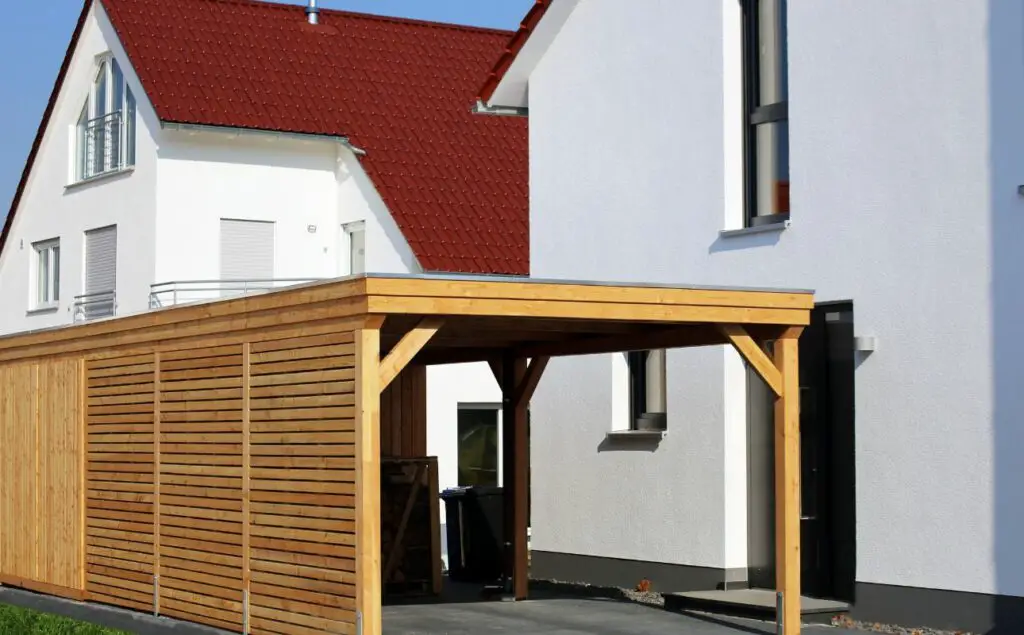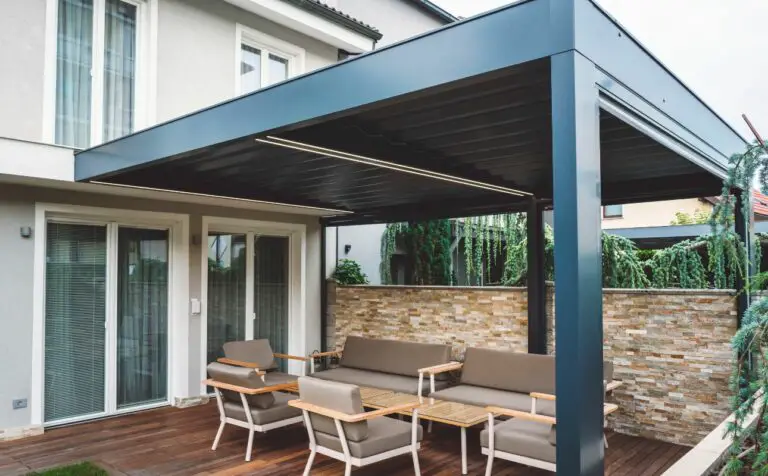When it comes to providing shelter for vehicles, homeowners often have two options: a garage or a carport. While the terms may be used interchangeably, there are significant differences between the two structures that can impact their functionality and value.
A garage is typically an enclosed structure with walls and doors that provide complete protection for vehicles from weather conditions. On the other hand, a carport is an open-air structure with only a roof supported by poles or beams that provides partial shelter for vehicles.
In this article, we will explore the question of whether a carport can be considered a garage, examining the characteristics of each and highlighting key distinctions.

Definition and Characteristics of a Garage
Garages can come in different types, such as attached or detached, single-car or multi-car, and can be constructed using various materials including wood, steel, brick, or concrete.
A garage typically has a roof and walls for complete enclosure of the vehicle(s), along with a door for easy access in and out. It may also have windows for natural lighting and ventilation purposes.
In addition to sheltering cars from harsh weather conditions like snow and rain, garages often provide additional storage space for tools, equipment, bicycles, or other items.
Definition and Characteristics of a Carport
A carport is an open-air structure that provides shelter for vehicles. Unlike a garage, a carport does not have four walls and is typically made up of a roof and support beams. The roof of a carport can be made from different materials such as wood, metal, or polycarbonate panels, depending on the owner’s preference and budget.
Open-Air Structure
An open-air structure is a popular option for those who want to protect their vehicles from the elements without investing in a fully enclosed garage, with 25% of American households opting for this type of shelter according to a recent survey.
When considering the design of an open-air structure, it is important to take into account factors such as wind and snow load requirements, as well as local building codes and regulations.
Provides Shelter for Vehicles
One popular option for providing such protection is through the installation of a carport. While there are benefits and drawbacks to this open-air structure, its primary advantage lies in its ability to shield vehicles from harsh weather conditions such as rain, snow, and hail.
The installation process for a carport typically involves securing support beams into the ground and then attaching a roof to these posts. However, it is important to note that unlike garages which offer complete enclosure and security for vehicles, carports may still leave them exposed to potential theft or damage caused by animals or falling debris.
Roof and Support Beams
When considering the design of a carport or garage, several factors come into play. Design considerations include the slope and angle of the roof to ensure proper drainage, as well as its height to accommodate larger vehicles. Material options for both the roof and support beams range from wood to metal, each with their benefits in terms of durability and aesthetic appeal.
In addition to protecting vehicles from weather elements such as rain, snow, and hail, the roofing material also plays a vital role in blocking harmful UV rays that can fade paint jobs over time. Support beams not only provide structural stability but also add an extra layer of protection against strong winds or fallen debris during storms.
Differences Between a Garage and Carport
When comparing a garage and carport, one of the main differences is that garages are typically enclosed while carports are open-air structures.
This means that a garage offers better security features for vehicles as they can be locked up inside, while a carport leaves the vehicle exposed to potential theft or damage.
| Garage | Carport | |
| Enclosed Structure | Yes | No |
| Walls | Yes | No |
| Roof | Covered and enclosed | Covered, but open-sided |
| Security | Offers better security and protection | Limited security, as it is open on the sides |
| Storage | Provides secure storage for vehicles and other items | Offers minimal storage space |
| Construction | Requires complete construction with walls and doors | Simpler construction with posts and roof only |
| Cost | Generally more expensive due to added construction and materials | Typically less expensive than a garage |
| Flexibility | Can be converted into additional living space or used for other purposes | Limited flexibility for repurposing |
Garage and carport are two distinct types of structures used for vehicle shelter and storage. Here are some more differences between a garage and a carport:
Garage:
- Enclosed Structure: A garage is an enclosed structure with walls, a roof, and a secured entrance, providing complete coverage and protection for vehicles.
- Security: Due to its enclosed nature, a garage offers enhanced security and protection against theft and vandalism compared to a carport.
- Storage Space: Garages typically offer more storage options, with built-in shelves, cabinets, and overhead storage systems, allowing for the organization of tools, equipment, and other belongings.
- Versatility: A garage can be repurposed for other uses, such as a workshop, home gym, or additional living space. The enclosed design allows for climate control and customization.
- Construction: Building a garage involves complete construction, including walls, a roof, doors, and possibly windows. This requires more time, materials, and skilled labor compared to a carport.
- Cost: Garages tend to be more expensive than carports due to the added construction, materials, and security features.
Carport:
- Open-sided Structure: A carport is a roofed structure supported by posts or columns, providing overhead protection for vehicles without enclosing the sides.
- Roof: A carport’s roof offers shelter from sun, rain, and snow, but it remains open on the sides, allowing for easy access and ventilation.
- Limited Security: Carports provide limited security as they are open on the sides, making vehicles more accessible and potentially vulnerable to theft or damage.
- Minimal Storage: Carports typically do not provide built-in storage options, although freestanding storage units or shelves can be added.
- Simple Construction: Constructing a carport involves a simpler and quicker process compared to a garage, as it mainly requires installing posts, a roof, and anchor points.
- Cost: Carports are generally more affordable than garages due to their simpler construction and fewer materials.
Can a Carport be Considered a Garage?
While garages typically have four walls and a roof that are fully enclosed to provide maximum protection to vehicles, carports are usually open on one or more sides and may only have a roof supported by posts or columns.
This means that while carports offer some level of protection from the elements such as sun, rain, and snow, they do not provide full coverage against theft or vandalism.
Carports require less maintenance compared to garages as they do not have doors that need regular upkeep. However, one should consider the pros and cons before deciding between the two options.
Choosing Between a Garage and Carport
Two popular options are garages and carports. While both can provide shelter for vehicles from sun, rain, and other elements, there are some differences to consider when choosing between them.
Cost comparison is a major factor to consider since garages typically cost more than carports due to the additional materials and labor involved in constructing a fully enclosed space.
On the other hand, carports have a smaller environmental impact since they require fewer materials to build and do not consume energy for lighting or ventilation like garages do.
Other considerations include personal preference for open vs. closed spaces, ease of access for parking and maintenance tasks, as well as security needs such as locking doors or surveillance systems.
The Bottom Line
While garages provide complete protection for vehicles, they are more expensive to construct and maintain. On the other hand, carports offer partial protection but are more affordable and easier to install.
It is important to note that in some cases, local building codes may require a certain level of protection for vehicles, which may dictate whether one should opt for a garage or carport.
Ultimately, the decision of whether to choose a garage or carport depends on various factors such as budget, climate conditions, and personal preferences.
FAQ
How much does it cost to build a carport compared to a garage?
The cost of building a carport is generally lower compared to constructing a garage. Carports typically range in cost from around $1,000 to $5,000, depending on factors such as size, materials, design complexity, and any additional features.
On the other hand, building a garage can range from $10,000 to $50,000 or more, depending on similar factors as well as the level of customization, insulation, electrical wiring, and other considerations.
The specific costs for both carports and garages can vary significantly based on location, materials used, and individual project requirements.
Can a carport be converted into a garage?
Yes, a carport can potentially be converted into a garage. However, the feasibility of conversion depends on several factors such as the existing structure, local building codes, and your specific needs.
Converting a carport into a garage typically involves enclosing the sides, adding walls, doors, windows, and potentially making modifications to the roof. This conversion process may require professional assistance, including permits and compliance with building regulations.
Are carports less secure than garages?
Yes, carports are generally less secure than garages. Carports are open-sided structures, leaving vehicles exposed to potential theft or damage compared to garages, which have enclosed walls and doors. The open design of carports makes it easier for unauthorized individuals to access vehicles or belongings stored within. However, security measures can be taken, such as installing security cameras, motion-sensor lights, or additional locking mechanisms, to enhance the security of a carport.





